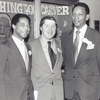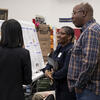Our History
Do you know who George Washington Carver is? Learn more about Carver and his life.
In 1976, Frank Hess, Jr., the former director of community relations for the Gulf Oil Corporation, met with Alfred Morris, then the president of the Philadelphia Tribune newspaper, to organize an art contest as a way of bringing the many contributions of Dr. George Washington Carver to the attention of the Philadelphia public.
Thomas Anderson, the co-founder of the George Washington Carver Science Fair, left a legacy of instilling a passion for science for thousands of children and youth in Philadelphia and the surrounding regions.
In 1977, Anderson served as a former Associate Vice President at Temple University’s Office of Community Relations (now known as the Office of Community Affairs and Engagement). During his time as an employee he co-founded a commemorative program that evolved into the science fair. As a former teacher, he was passionate about ensuring that young people were introduced to science.
“Someone has to do it for the kids,” said Anderson. “It’s the love of my life and it became a part of me.”
In his tenure many Carver winners would place at other regional fairs and several Carver contestants would pursue Science, Technology, Engineering and Mathematics (STEM) majors in college.
Anderson was devoted to the fair and served as director until he died in 2019.




